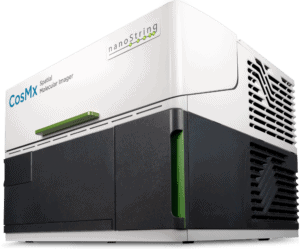
NanoString Powered by NVIDIA GPU Technology Accelerates Scientific Discovery and the Age of Spatial Biology
For researchers studying diseases that cruelly take the lives of millions — Alzheimer’s disease, lung, colon, breast, and pancreatic cancer, among others — it has been a long-held dream to understand and characterize the proteins and RNA molecules within a single human biopsy. Within those millions of data points lies untold information about disease and human health.
At NanoString, our scientists have taken up the challenge to invent and deliver leading-edge technologies capable of imaging human tissue samples to reveal precisely what proteins and RNA are signaling at a specific point in time. The innovative discipline known as spatial biology integrates RNA and protein data with imaging-driven spatial localization offering unprecedented insights on diseased and healthy cells.
The CosMx™ SMI and decoder probes are not offered and/or delivered to the Federal Republic of Germany for use in the Federal Republic of Germany for the detection of cellular RNA, messenger RNA, microRNA, ribosomal RNA and any combinations thereof in a method used in fluorescence in situ hybridization for detecting a plurality of analytes in a sample without the consent of the President and Fellows of Harvard College (Harvard Corporation) as owner of the German part of EP 2 794 928 B1. The use for the detection of cellular RNA, messenger RNA, microRNA, ribosomal RNA and any combinations thereof is prohibited without the consent of the President and Fellows of Harvard College (Harvard Corporation).
The unmatched technology advanced by NanoString would not be possible without the vital components that sit on the motherboard of the instrument: NVIDIA GPUs. The powerful graphics processing units (GPUs) that currently power applications such as ChatGPT also accelerate computing on the CosMx™ Spatial Molecular Imager (SMI) platform.
The synergy between NanoString and NVIDIA’s technologies enhances understanding of biological structures and functions at a cellular level, enabling discoveries with untold potential for therapeutic applications. With spatial biology at the forefront, life sciences research enters a new era of transformation.
Ushering in New Era of Biological Research
At the cusp of this revolution lies our CosMx SMI, the first fully integrated single-cell spatial analysis platform. Together with our cloud-based informatics software, AtoMx™ Spatial Informatics Platform, researchers can view, analyze, and collaborate on single-cell spatial datasets anytime and anywhere. CosMx SMI takes the leap in spatial biology by helping unravel the interactions between either proteins or RNA transcripts and their functional interaction in cells and tissues. The applications of the technology are already proving to be extraordinary.
In Dr. Miranda Orr’s lab at Wake Forest University, the study of senescence or of “zombie cells” is the core of her team’s work. These unusual cells oddly stop multiplying and functioning normally but do not die, much like fictional zombies. What’s most alarming is they are present in many aging brains. The Orr lab has shown a higher prevalence in the brains of people who have suffered and died from Alzheimer’s disease.
By utilizing the CosMx SMI supercharged with powerful NVIDIA GPU technology, Dr. Orr’s team has mapped diseased brain tissue to characterize senescent cells, to investigate their contributions to Alzheimer’s disease and search for novel biomarkers. The findings are being translated into exciting clinical trials. This innovative approach not only uncovers critical insights into neurodegenerative diseases but also propels the development of targeted therapies, revolutionizing treatment strategies for age-related conditions—something that Dr. Orr and her team are passionately working on as well.
Accelerated Computing Harnesses Single-Cell Spatial Biology
For NVIDIA, the leap from its origins in the gaming industry to life sciences is a natural evolution for GPU technology. GPUs are designed for high-performance computing, traditionally used for parallel computing when rendering graphics in gaming, among other applications. However, its capabilities extend far beyond graphics. GPUs are used in artificial intelligence, deep learning, and scientific computing for their capacity to process multiple tasks concurrently, with extraordinary efficiency. This makes them ideal for handling complex computations in various fields, including life sciences, where they can analyze enormous datasets quickly and accurately.
NanoString has collaborated with NVIDIA to accelerate the computational processes onboard the CosMx SMI. Leveraging NVIDIA GPUs has not only given the CosMx SMI the capacity to handle complex data processing requirements but also sets a new standard in accuracy and efficiency in cell segmentation.
Leveraging NVIDIA GPUs has not only given the CosMx SMI the capacity to handle complex data processing requirements, it also sets a new standard in accuracy and efficiency in cell segmentation.
NanoString Principal Scientist Aster Wardhani, PhD, and her team use the NVIDIA GPUs to train a best-in-class cell segmentation model to accurately recognize patterns between different tissue types to define cell boundaries.
“The use of both AI technology and GPU processing is crucial to getting us the most precise and fastest cell segmentation that we can achieve right now,” explained Dr. Wardhani. She is keenly focused on pushing its capabilities to continue expanding its utility for researchers. The CosMx SMI is designed to spatially identify and count all cells in tissue samples, with the capability to find between 5,000 to 15,000 cells in a single image and up to 72 million cells of types in a single experiment. The system has a remarkable ability to handle large-scale cell analysis efficiently.
“We can use AI to interrogate image data and connect the features of cell structure to the rest of that rich protein and RNA data and get a broad understanding of the underlying biological function,” said George Vacek, global lead for genomics alliances at NVIDIA. “The universe of information this type of technology offers researchers is extraordinary.”
The Future of Biology
The CosMx SMI has been pushing the envelope from day one with its high plex RNA and protein panels. The platform continues to evolve. Its forthcoming CosMx Human 6K Discovery Panel will enable researchers to detect over 6,000 unique RNA molecules in a single tissue section.
NanoString’s collaboration with NVIDIA launches the next chapter in the convergence of information technology and biological research, ushering in an era of rapid, data-driven discoveries that could open new frontiers for life sciences research and therapeutic development. For scientists, including Dr. Miranda Orr, the technology’s potential to accelerate research for patient benefit is extraordinary.





